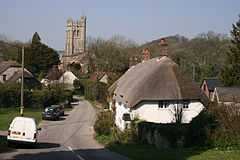Piddletrenthide
| Piddletrenthide | |
 Piddletrenthide |
|
 Piddletrenthide |
|
| Population | 647 [1] |
|---|---|
| OS grid reference | ST703000 |
| District | West Dorset |
| Shire county | Dorset |
| Region | South West |
| Country | England |
| Sovereign state | United Kingdom |
| Police | Dorset |
| Fire | Dorset |
| Ambulance | South Western |
| EU Parliament | South West England |
Coordinates: 50°48′03″N 2°25′21″W / 50.8007°N 2.4226°W

Piddletrenthide /ˌpɪdəltrɛntˈhaɪd/ is a village and civil parish in the English county of Dorset. It is sited by the small River Piddle in a valley on the dip slope of the Dorset Downs, 8 miles (13 km) north of Dorchester. It lies within the West Dorset administrative district. In the 2011 census the parish—which includes the small village of Plush to the northeast—was 647.[1]
The unusual name of the village is derived from its position on the River Piddle, combined with it having been assessed for thirty hides in the Domesday Book. The name is considered by some to be inherently funny, resulting in it being something of a running joke in parts of the British media; references were made to it in the TV Times (25 April-1 May 1970), The Times (a lengthy correspondence in 1974, then again on 27 March 1999), The Sunday Times ( 22 December 2002 and 25 September 2005), and The Guardian (8 May 2004).
Piddletrenthide is a long village, divided into three tithings. The church and manor house is the upper tithing, another group of cottages form the middle, and the third is known as White Lackington. In 1086 in the Domesday Book it was recorded as Pidrie;[2] it had 70 households, 17 ploughlands, 16 acres (6.5 ha) of meadow, 3 mills and a taxable value of 30 geld units. It was in Cerne, Totcombe and Modbury Hundred and the tenant-in-chief was Winchester Abbey.[3]
Piddletrenthide church has a claim to being one of the finest village churches in Dorset,[4] with a splendid 15th-century tower and gruesome gargoyles. The south doorway and piers of the chancel arch are Norman. Over the west door of the church-tower is the Latin inscription "Est pydeltrenth villa in dorsedie comitatu Nascitur in illa quam rexit Vicariatu 1487". The inscription translates as: "It is in Piddletrenthide, a town in Dorset [where] he was born [and] is Vicar, 1487." As the vicar in that year was Nicholas Locke, presumably the tower was dedicated to him. This is an early use of Arabic numerals in England at a time when the use of Roman numerals continued for another century elsewhere in England.
The BBC Radio broadcaster Ralph Wightman (1901–1971), who was the model for Kenneth Williams' country character Arthur Fallowfield, came from here and was noted in his radio broadcasts for his fine Dorset accent.
Piddletrenthide was also featured as the hometown of Jem Kellaway, one of the main protagonists in Tracy Chevalier's 18th-century-set novel Burning Bright.
At the Alton Pancras end of the village, reached by a footpath from the Poachers Inn, is Morning Well (or Mourning Well), where several springs feed into the River Piddle. In his book Portrait of Dorset Ralph Wightman described it as where "springs bubble out of the base of a steep wooded hill into a shady pool....It is an enchanted place, raising memories of holy wells and pagan groves."[4]
Scrumpy and Western artist Trevor Crozier wrote a song entitled "The Piddletrenthide Jug Band" for Dorset folk group The Yetties.[5]
References
- ↑ 1.0 1.1 "Area: Piddletrenthide (Parish), Key Figures for 2011 Census: Key Statistics". Neighbourhood Statistics. Office for National Statistics. Retrieved 13 March 2014.
- ↑ "Dorset H-R". The Domesday Book Online. domesdaybook.co.uk. Retrieved 28 February 2015.
- ↑ "Place: Piddletrenthide". Open Domesday. domesdaymap.co.uk. Retrieved 28 February 2015.
- ↑ 4.0 4.1 Ralph Wightman (1983). Portrait of Dorset (2 ed.). Robert Hale. p. 106. ISBN 0 7090 0844 9.
- ↑ "Trevor Crozier". somersetmade ltd. Retrieved 2011-04-05.
External links
| Wikimedia Commons has media related to Piddletrenthide. |
